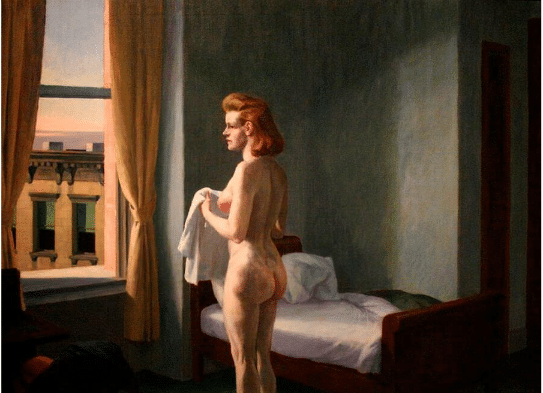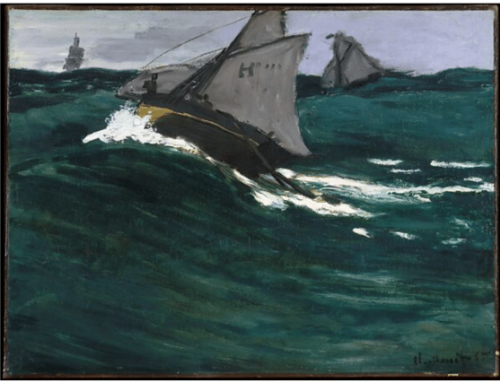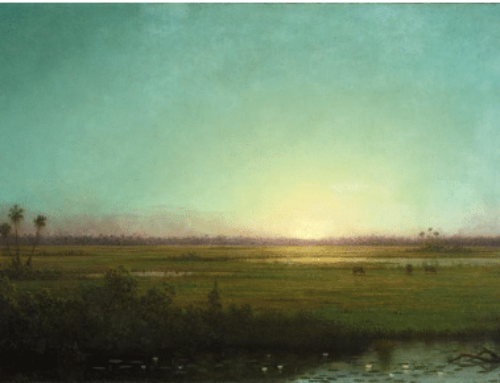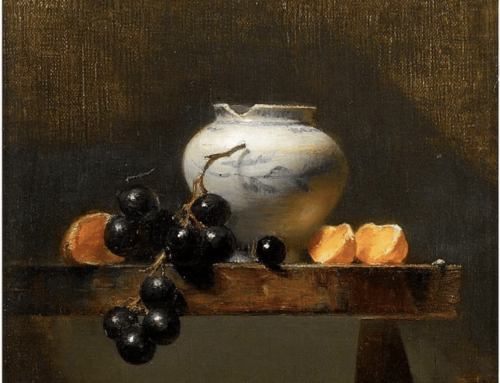“Poetry is a man and a woman and the distance between them.” – Lawrence Ferlinghetti
Edward Hopper’s figures have no one talk to. They’re entirely self-absorbed, isolated from each other even when together, and most of the time they’re alone.
“Hopper’s people, in various hotel rooms, dressed, undressed, semi-dressed — they’re all waiting for something,” said a recent commentator on National Public Radio. “In a 1944 canvas, Morning in the City, a nude woman stands by her bed holding something white — A towel? A blouse? — and looking out the window.”
Hopper was one of the early American artists to paint the experience of human isolation in the modern city. He painted numerous pictures of women in hotel rooms, train stations, and sterile city apartments. The settings are never “homey.” On the contrary, they’re always impersonal between-places – somewhere one finds oneself in transit, a frozen moment between a place one’s left behind and wherever one is headed next.
The men and women in Hopper could be anyone because, while we know they’re someone (he gives each of his figures an evident, if not brooding, inner life), we can never know anything more about them than what little we see on the surface. Their faces tend to express very little, their settings reduced to the most basic architectural elements, devoid of anything more than a sparse jumble of inconclusive narrative clues.
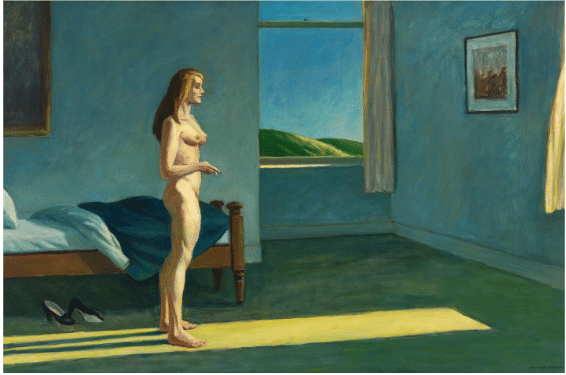
Edward Hopper, A Woman in the Sun, 40 1/8 × 60 3/16in., 1961, Whitney Museum of American Art, New York; 50th Anniversary Gift of Mr. and Mrs. Albert Hackett in honor of Edith and Lloyd Goodrich.
Struck perhaps by the strange combination of stark realism and the lack of personal identification, the poet Lisel Mueller gave one of Hopper’s nudes a voice. In her poem A Nude by Edward Hopper, the poet speaks in the imagined voice of one of these “waiting woman.” As if to breach the nude’s sense of separateness and solitary selfhood, the poet identifies her own inner self with the outward appearance of the figure.
A Nude by Edward Hopper
The light
drains me of what I might be,
a man’s dream
of heat and softness;
or a painter’s
- breasts cozy pigeons,
arms gently curved
by a temperate noon.
I am
blue veins, a scar,
a patch of lavender cells,
used thighs and shoulders;
my calves
are as scant as my cheeks,
my hips won’t plump
small, shimmering pillows:
but this body
is home, my childhood
is buried here, my sleep
rises and sets inside,
desire
created and wore itself thin
between these bones –
I live here.
- Lisel Mueller
We’re not told which painting inspired Mueller’s poem, and it doesn’t really matter. Hopper paints personal inwardness within in an impersonal outwardness, to which the poet lends her own voice. By the way, Hopper’s wife, Josephine — at her insistence — was the model for all these waiting women.
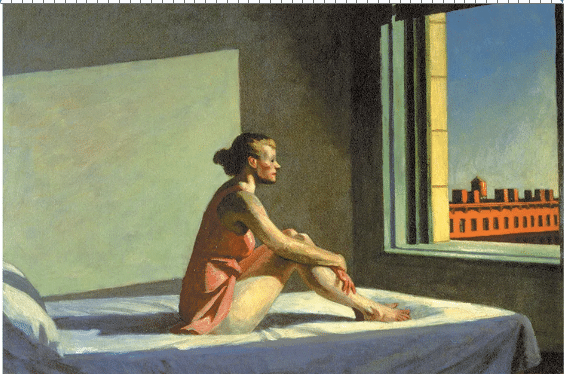
Edward Hopper, Morning Sun, 1952
In Morning Sun of 1952, the figure stares into the rather harsh light of the sun rising over the city. This is not the sort of honeyed light that’s complementary, kind, or forgiving. The figure is alternately pale, gray, and, at her face, feet, and toes, a raw, all-too-fleshy pink. Her coral-colored dress (or is it a short nightgown?) mirrors the brick factory building of which she notices nothing as she stares straight into space.
In Hotel Room from 1931, a woman sits on a bed reading a train schedule. In this one the woman seems trapped in inner and outer space: there are no windows or natural light. As in all of these paintings, we remain entirely outside looking in.
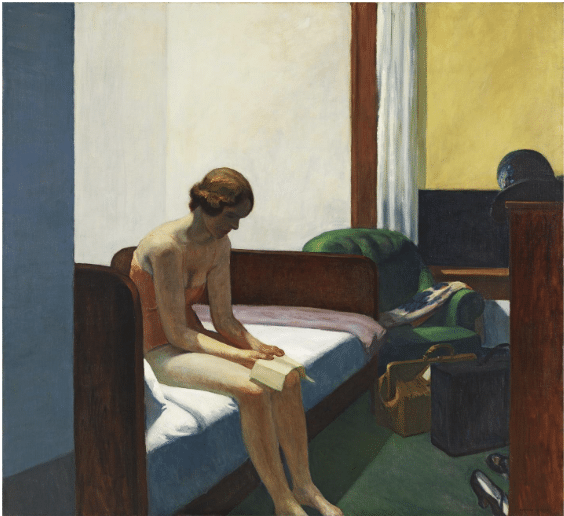
Edward Hopper, Hotel Room, 1931, Thyssen-Bornemisza National Museum Madrid
“We see moments of pause, those in-betweens that interest us,” one art historian says. “It’s isolation; it’s alienation. But it’s also coming to a pause when there’s really nowhere to go and nothing to do.”
Hopper’s world is also our own, and work remains a strong argument for the continued relevance of realism and its ability to reveal truths of the modern world we inhabit daily. That relevance is a core tenet of Realism Live, a three-day online conference live-streamed via free software to your preferred Internet-ready device. The conference includes demos, presentations, lectures, break-out sessions, a private Facebook community, and roundtables in which the artists have in depth discussions that give an inside look at their lives and their work. Register yourself now for the Realism conference of the year by clicking here.<< https://realismlive.com/rl2023
Spend the Night in an Edward Hopper Painting

Edward Hopper’s 1957 oil on canvas Western Motel (left) has been re-created (right) at the Virginia Museum of Fine Arts. NPR’s Susan Stamberg recently stayed overnight.
Yale University Art Gallery / Travis Fullerton, Virginia Museum of Fine Arts
Wouldn’t it be interesting to put yourself in one of Hopper’s hotel room paintings and see for yourself what it feels like? For $150 a night you can sleep in one, or a reproduction of one anyway — at the Virginia Museum of Fine Arts in Richmond, VA. Designers there have constructed a 3D version of Hopper’s 1957 Western Motel and invited Hopper fans to sleep over in the museum.
Sense of humor recommended (actual harsh sunlight not included).

